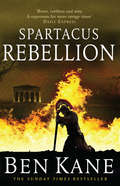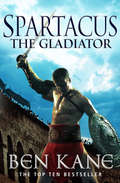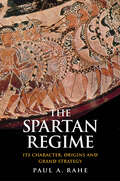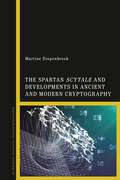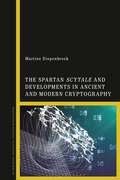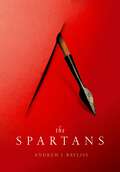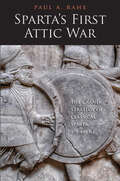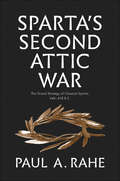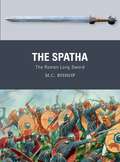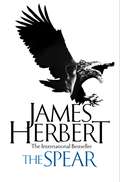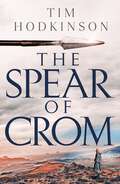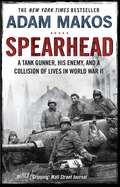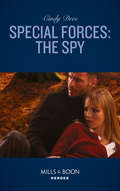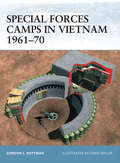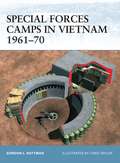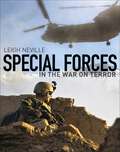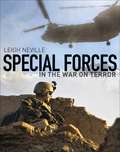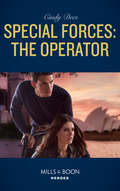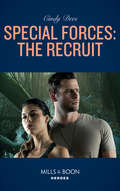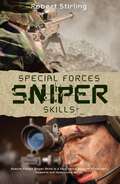- Table View
- List View
Spartacus: (Spartacus 2) (Spartacus #2)
by Ben KaneHe marches to freedom - or to bloody war. The epic story of Spartacus the legendary gladiator. From the Sunday Times bestselling author of Hannibal: Enemy of Rome and Spartacus: The Gladiator.The mighty slave army, led by Spartacus, has crushed all before it, scattering the legions of Rome. Now invincible, he marches towards the Alps and freedom.But storm clouds are growing on the horizon. Crassus, the richest man in Rome, has raised an army to rival Spartacus, and there are murmurings of rebellion in Spartacus’ own army.Spartacus, on the brink of glory, must make a crucial decision - to go forward over the Alps to freedom, or back to face the might of Rome and try to break its power forever.'Compulsive, relentless ... vividly recounted in muscular prose' Daily Telegraph'A brutal, blood-spattered novel' BBC History Magazine
Spartacus: (Spartacus 1) (Spartacus #1)
by Ben KaneThe first of two epic novels which tell the story of one of the most charismatic heroes history has ever known - Spartacus, the gladiator slave who took on and nearly defeated the might of Rome, during the years 73-71 BC.Historically very little is known about Spartacus. We know that he came from Thrace, a land north of Greece, that he once fought in the Roman legions and that, during two fateful years, he led a slave army which nearly brought Rome to its knees.In Ben Kane's brilliant novel, we meet Spartacus as he returns to Thrace, ready to settle down after a decade away. But a new king has usurped the throne. Treacherous and violent, he immediately seizes Spartacus and sells him to a Roman slave trader looking for new gladiators.The odyssey has begun which will see Spartacus become one of the greatest legends of history, the hero of revolutionaries from Karl Marx to Che Guevara, immortalised on screen, and now brought to life in Ben Kane's great bestseller - a novel which takes the story to its halfway point and is continued in Spartacus: Rebellion.Ben Kane was born in Kenya and raised there and in Ireland. He studied veterinary medicine and University College, Dublin, but after that he travelled the world extensively, indulging in his passion for ancient history. He lives in North Somerset with his wife and two young children.
The Spartan Regime: Its Character, Origins, and Grand Strategy (Yale Library of Military History)
by Paul Anthony RaheAn authoritative and refreshingly original consideration of the government and culture of ancient Sparta and her place in Greek history For centuries, ancient Sparta has been glorified in song, fiction, and popular art. Yet the true nature of a civilization described as a combination of democracy and oligarchy by Aristotle, considered an ideal of liberty in the ages of Machiavelli and Rousseau, and viewed as a forerunner of the modern totalitarian state by many twentieth-century scholars has long remained a mystery. In a bold new approach to historical study, noted historian Paul Rahe attempts to unravel the Spartan riddle by deploying the regime-oriented political science of the ancient Greeks, pioneered by Herodotus, Thucydides, Plato, Xenophon, and Polybius, in order to provide a more coherent picture of government, art, culture, and daily life in Lacedaemon than has previously appeared in print, and to explore the grand strategy the Spartans devised before the arrival of the Persians in the Aegean.
The Spartan Scytale and Developments in Ancient and Modern Cryptography
by Dr Martine DiepenbroekThis book offers a comprehensive review and reassessment of the classical sources describing the cryptographic Spartan device known as the scytale. Challenging the view promoted by modern historians of cryptography which look at the scytale as a simple and impractical 'stick', Diepenbroek argues for the scytale's deserved status as a vehicle for secret communication in the ancient world. By way of comparison, Diepenbroek demonstrates that the cryptographic principles employed in the Spartan scytale show an encryption and coding system that is no less complex than some 20th-century transposition ciphers. The result is that, contrary to the accepted point of view, scytale encryption is as complex and secure as other known ancient ciphers. Drawing on salient comparisons with a selection of modern transposition ciphers (and their historical predecessors), the reader is provided with a detailed overview and analysis of the surviving classical sources that similarly reveal the potential of the scytale as an actual cryptographic and steganographic tool in ancient Sparta in order to illustrate the relative sophistication of the Spartan scytale as a practical device for secret communication. This helps to establish the conceptual basis that the scytale would, in theory, have offered its ancient users a secure method for secret communication over long distances.
The Spartan Scytale and Developments in Ancient and Modern Cryptography
by Dr Martine DiepenbroekThis book offers a comprehensive review and reassessment of the classical sources describing the cryptographic Spartan device known as the scytale. Challenging the view promoted by modern historians of cryptography which look at the scytale as a simple and impractical 'stick', Diepenbroek argues for the scytale's deserved status as a vehicle for secret communication in the ancient world. By way of comparison, Diepenbroek demonstrates that the cryptographic principles employed in the Spartan scytale show an encryption and coding system that is no less complex than some 20th-century transposition ciphers. The result is that, contrary to the accepted point of view, scytale encryption is as complex and secure as other known ancient ciphers. Drawing on salient comparisons with a selection of modern transposition ciphers (and their historical predecessors), the reader is provided with a detailed overview and analysis of the surviving classical sources that similarly reveal the potential of the scytale as an actual cryptographic and steganographic tool in ancient Sparta in order to illustrate the relative sophistication of the Spartan scytale as a practical device for secret communication. This helps to establish the conceptual basis that the scytale would, in theory, have offered its ancient users a secure method for secret communication over long distances.
The Spartans
by Andrew J. BaylissThe image of Sparta, and the Spartans, is one dyed indelibly into the public consciousness: musclebound soldiers with long hair and red cloaks, bearing shiny bronze shields emblazoned with the Greek letter lambda. 'This is Sparta!', bellows Leonidas on the silver screen, as he decides to lead his 300 warriors to their deaths at Thermopylae. But what was Sparta? The myths surrounding Sparta are as old as the city itself. Even in antiquity, Sparta was a unique society, considered an enigma. The Spartans who fought for freedom against the Persians called themselves 'equals' or peers, but their equality was reliant on the ruthless exploitation of the indigenous population known as helots. The Spartans' often bizarre rules and practices have the capacity to horrify as much they do to fascinate us today. Athenian writers were intrigued and appalled in equal measure by a society where weak or disabled babies were said to have been examined carefully by state officials before being dumped off the edge of a cliff. Even today their lurid stories have shaped our image of Sparta; a society in which cowards were forced to shave off half their beards, to dress differently from their peers, and who were ultimately shunned to the extent that suicide seemed preferable. Equally appalling to us today is the brutal krypteia, a Spartan rite of passage where teenagers were sent into the countryside armed with a knife and ordered to eliminate the biggest and most dangerous helots. But the truth behind these stories of the exotic other can be hard to discover, lost amongst the legend of Sparta which was even perpetuated by later Spartans, who ran a thriving tourist industry that exaggerated the famed brutality of their ancestors. As Andrew Bayliss explores in this book, there was also much to admire in ancient Sparta, such as the Spartans' state-run education system which catered even to girls, or the fact that Sparta was almost unparalleled in the pre-modern world in allowing women a clear voice, with no fewer than forty sayings by Spartan women preserved in our sources. This book reveals the best and the worst of the Spartans, separating myth from reality.
The Spartans
by Andrew J. BaylissThe image of Sparta, and the Spartans, is one dyed indelibly into the public consciousness: musclebound soldiers with long hair and red cloaks, bearing shiny bronze shields emblazoned with the Greek letter lambda. 'This is Sparta!', bellows Leonidas on the silver screen, as he decides to lead his 300 warriors to their deaths at Thermopylae. But what was Sparta? The myths surrounding Sparta are as old as the city itself. Even in antiquity, Sparta was a unique society, considered an enigma. The Spartans who fought for freedom against the Persians called themselves 'equals' or peers, but their equality was reliant on the ruthless exploitation of the indigenous population known as helots. The Spartans' often bizarre rules and practices have the capacity to horrify as much they do to fascinate us today. Athenian writers were intrigued and appalled in equal measure by a society where weak or disabled babies were said to have been examined carefully by state officials before being dumped off the edge of a cliff. Even today their lurid stories have shaped our image of Sparta; a society in which cowards were forced to shave off half their beards, to dress differently from their peers, and who were ultimately shunned to the extent that suicide seemed preferable. Equally appalling to us today is the brutal krypteia, a Spartan rite of passage where teenagers were sent into the countryside armed with a knife and ordered to eliminate the biggest and most dangerous helots. But the truth behind these stories of the exotic other can be hard to discover, lost amongst the legend of Sparta which was even perpetuated by later Spartans, who ran a thriving tourist industry that exaggerated the famed brutality of their ancestors. As Andrew Bayliss explores in this book, there was also much to admire in ancient Sparta, such as the Spartans' state-run education system which catered even to girls, or the fact that Sparta was almost unparalleled in the pre-modern world in allowing women a clear voice, with no fewer than forty sayings by Spartan women preserved in our sources. This book reveals the best and the worst of the Spartans, separating myth from reality.
Sparta's First Attic War: The Grand Strategy of Classical Sparta, 478-446 B.C. (Yale Library of Military History)
by Paul Anthony RaheA companion volume to The Spartan Regime and The Grand Strategy of Classical Sparta that explores the collapse of the Spartan†‘Athenian alliance During the Persian Wars, Sparta and Athens worked in tandem to defeat what was, in terms of relative resources and power, the greatest empire in human history. For the decade and a half that followed, they continued their collaboration until a rift opened and an intense, strategic rivalry began. In a continuation of his series on ancient Sparta, noted historian Paul Rahe examines the grounds for their alliance, the reasons for its eventual collapse, and the first stage in an enduring conflict that would wreak havoc on Greece for six decades. Throughout, Rahe argues that the alliance between Sparta and Athens and their eventual rivalry were extensions of their domestic policy and that the grand strategy each articulated in the wake of the Persian Wars and the conflict that arose in due course grew out of the opposed material interests and moral imperatives inherent in their different regimes.
Sparta's Second Attic War: The Grand Strategy of Classical Sparta, 446-418 B.C. (Yale Library of Military History)
by Paul Anthony RaheIn a continuation of his multivolume series on ancient Sparta, Paul Rahe narrates the second stage in the six-decades-long, epic struggle between Sparta and Athens that first erupted some seventeen years after their joint victory in the Persian Wars. Rahe explores how and why open warfare between these two erstwhile allies broke out a second time, after they had negotiated an extended truce. He traces the course of the war that then took place, he examines and assesses the strategy each community pursued and the tactics adopted, and he explains how and why mutual exhaustion forced on these two powers yet another truce doomed to fail. At stake for each of the two peoples caught up in this enduring strategic rivalry, as Rahe shows, was nothing less than the survival of its political regime and of the peculiar way of life to which that regime gave rise.
The Spatha: The Roman Long Sword (Weapon)
by M.C. BishopAdopted from the Celts in the 1st century BC, the spatha, a lethal and formidable chopping blade, became the primary sword of the Roman soldier in the Later Empire. Over the following centuries, the blade, its scabbard, and its system of carriage underwent a series of developments, until by the 3rd century AD it was the universal sidearm of both infantry and cavalry. Thanks to its long reach, the spatha was the ideal cavalry weapon, replacing the long gladius hispaniensis in the later Republican period. As the manner in which Roman infantrymen fought evolved, styles of hand-to-hand combat changed so much that the gladius was superseded by the longer spatha during the 2nd century AD. Like the gladius, the spatha was technologically advanced, with a carefully controlled use of steel. Easy maintenance was key to its success and the spatha was designed to be easily repaired in the field where access to a forge may have been limited. It remained the main Roman sword into the Late Roman period and its influence survived into the Dark Ages with Byzantine, Carolingian and Viking blades. Drawing together historical accounts, excavated artefacts and the results of the latest scientific analyses of the blades, renowned authority M.C. Bishop reveals the full history of the development, technology, training and use of the spatha: the sword that defended an empire.
The Spatha: The Roman Long Sword (Weapon #72)
by M.C. BishopAdopted from the Celts in the 1st century BC, the spatha, a lethal and formidable chopping blade, became the primary sword of the Roman soldier in the Later Empire. Over the following centuries, the blade, its scabbard, and its system of carriage underwent a series of developments, until by the 3rd century AD it was the universal sidearm of both infantry and cavalry. Thanks to its long reach, the spatha was the ideal cavalry weapon, replacing the long gladius hispaniensis in the later Republican period. As the manner in which Roman infantrymen fought evolved, styles of hand-to-hand combat changed so much that the gladius was superseded by the longer spatha during the 2nd century AD. Like the gladius, the spatha was technologically advanced, with a carefully controlled use of steel. Easy maintenance was key to its success and the spatha was designed to be easily repaired in the field where access to a forge may have been limited. It remained the main Roman sword into the Late Roman period and its influence survived into the Dark Ages with Byzantine, Carolingian and Viking blades. Drawing together historical accounts, excavated artefacts and the results of the latest scientific analyses of the blades, renowned authority M.C. Bishop reveals the full history of the development, technology, training and use of the spatha: the sword that defended an empire.
Spätverfolgung von NS-Unrecht
by Moritz Vormbaum75 Jahre nach dem Nürnberger Hauptkriegsverbrecherprozess ist die Strafverfolgung der nationalsozialistischen Systemverbrechen faktisch abgeschlossen. Der Band nimmt den letzten Akt der Strafverfolgung von NS-Unrecht in Deutschland in den Blick. Er knüpft an die in Wissenschaft, Praxis und allgemeiner Öffentlichkeit geführten Debatten über die Spätverfolgung an, zu einem Zeitpunkt, an dem die Erinnerung an die Verfahren noch frisch ist. Disziplinenübergreifend bietet der Band Analysen verschiedener Aspekte der Spätverfolgung und verknüpft das Thema mit dem internationalen "transitional justice"-Diskurs.Die Kapitel 1 Einführung, 11 Spätverfolgung von NS-Unrecht – Reflexionen der Nebenklagevertretung und 20 Ausgeforscht? Zeitgeschichte und juristische Ahndung von NS-Verbrechen sind unter einer Creative Commons Attribution 4.0 International License über link.springer.com frei verfügbar (Open Access).
The Spear (Isis (cds) Ser.)
by James HerbertThe Spear, is a gripping supernatural thriller by the master of horror, James Herbert.A young Mossad agent is found dead and private detective Harry Steadman is asked to investigate. On the hunt for a sinister arms dealer, however, what he discovers is a conspiracy of unfathomable horror. Neo-nazi cultists want to unleash an ancient and demonic power. A power so terrible it threatens the world itself . . .
The Spear of Crom
by Tim HodkinsonIn first-century Roman Britain, a Celtic warrior rides out on a deadly mission. A thrilling blend of legend and history, bloody battles and daring deeds by the author of the Whale Road Chronicles.A priceless relic – a thankless quest – who will make it out alive? Britannia, 58 AD. Fergus MacAmergin is a man out of place. An Irish Celt, he passes as a Gaul and rides with the Roman cavalry, affirming Nero's control over the province. Fergus dreams of escaping the fetters ofhis birth and living freely as a citizen of Rome.When Fergus's commander makes a battlefield error, Fergus is blamed. He and his men are given a thankless task: a quest that spells danger, despair, and near-certain death. The mission: to find the Holy Lance, the spear that wounded Christ on the Cross.The young Tribune Agricola is drawn into the quest, and he and Fergus must overlook their differences to survive. But there are plots and enemies everywhere. And just why is the Holy Lance so key to Roman mastery over Britannia?Reviews for Tim Hodkinson: 'A brilliantly written historical adventure' Historical Novel Society 'A gripping action adventure' Melisende's Library 'An excellently written page-turner' Historical Writers' Association
Spearhead: An American Tank Gunner, His Enemy and a Collision of Lives in World War II
by Adam MakosThe New York Times Bestseller'Brilliant... Gripping' Wall Street JournalFrom the Sunday Times bestselling author of A Higher Call comes the riveting World War II story of an American tank gunner's journey into the heart of the Third Reich. At first, gunner Clarence Smoyer and his fellow crewmen in the legendary 3rd Armored Division - 'Spearhead' - thought their tanks were invincible. Then they met the German Panther, with a gun so murderous it could shoot through one Sherman and into the next. Soon a pattern emerged: the lead tank always gets hit.After Clarence sees his friends cut down breaching the West Wall and holding the line in the Battle of the Bulge, he and his crew are given a weapon with the power to avenge their fallen brothers: the Pershing, a state-of-the-art 'super tank', one of twenty in the European theatre.But with it comes a harrowing new responsibility: now they will spearhead every attack. That's how Clarence finds himself leading the U.S. Army into its largest urban battle of the European war, the fight for Cologne, the 'Fortress City' of Germany.Battling through the ruins, Clarence will engage the fearsome Panther in a duel immortalized by an army cameraman. And he will square off with Gustav Schaefer, a teenager behind the trigger in a Panzer IV tank, whose crew has been sent on a suicide mission to stop the Americans.As Clarence and Gustav trade fire down a long boulevard, they are confronted by a tragic mistake of war. What happens next will haunt Clarence to the modern day, drawing him back to Cologne to do the unthinkable: to face his enemy, one last time.
Special Force: The Untold Story of 22nd Special Air Service Regiment (SAS)
by Alastair MacKenzieThe exploits of the British Army's elite 22nd Special Air Service Regiment - the regiment of the SAS that forms part of the Regular army - are shrouded in mystery and myths abound about its members. But what is the truth behind the public façade of clinical professionalism? How has such a small regiment attracted so many weighty legends? And what is the purpose of the SAS in the 21st century?Special Force provides an original and unusually critical overview of the activities of the SAS from the Malayan Emergency of 1950 to the present day. After its disbandment as a regular unit of the British Army after the Second World War, the 22nd Special Air Service Regiment was re-established in the jungles of Malaya in 1950 to assist in the counter-insurgency campaign against the Chinese Communist Terrorists. More than half a century later the SAS has become the 'weapon of first choice' in UK military deployments. In this powerful and provocative book, Alastair MacKenzie analyses the reasons behind this development and questions what it reveals about for the relationship between the armed forces, the public and politicians in the present day.In the context of a detailed and often controversial analysis of the post-war activities of the Regiment, MacKenzie establishes that the Regiment's almost legendary professional competence is often not backed up by reality. Far from being part of a structured deployment of strategic military assets, MacKenzie argues that the use of the SAS in recent years has been primarily driven by the 'entrepreneurial' actions of a few SAS commanding officers. Special Force not only offers a revelatory history of the SAS in the modern period, it is also a disturbing exposé of the truth behind the myth. Mackenzie passionately stresses the need for a greater understanding of the strategic relevance of this unique military force to the UK's foreign and defence policy, arguing that the failure to understand the SAS's strengths and weaknesses could be fatal. Special Force will be essential reading for anyone with an interest in the British military - past, present and future.
Special Forces: Identical Stranger / Special Forces: The Spy (mission Medusa) (Mission Medusa #2)
by Cindy DeesA secret agent kidnaps an undercover operative!
Special Forces Camps in Vietnam 1961–70 (Fortress #33)
by Gordon L. RottmanIn 1961 US Special Forces units began entering remote areas of Vietnam dominated by the Viet Cong. Their task was to organize local defense and strike forces aimed at stopping the enemy from gaining further control of such areas. The Green Berets set up fortified camps from which indigenous troops defended local villages and attacked and harassed the enemy. How these camps were constructed, developed, and defended is documented here for the first time. This book also covers the weapons, barriers, and obstacles used in these camps, providing specific examples of camp design, and details how they withstood the test of battle against a determined and resourceful enemy.
Special Forces Camps in Vietnam 1961–70 (Fortress)
by Gordon L. Rottman Chris TaylorIn 1961 US Special Forces units began entering remote areas of Vietnam dominated by the Viet Cong. Their task was to organize local defense and strike forces aimed at stopping the enemy from gaining further control of such areas. The Green Berets set up fortified camps from which indigenous troops defended local villages and attacked and harassed the enemy. How these camps were constructed, developed, and defended is documented here for the first time. This book also covers the weapons, barriers, and obstacles used in these camps, providing specific examples of camp design, and details how they withstood the test of battle against a determined and resourceful enemy.
Special Forces in the War on Terror
by Leigh NevilleWithin weeks of 9/11, United States Special Operations Forces were dropping into Afghanistan to lead the war against Al Qaeda and the Taliban. For over a decade special forces have been fighting a hidden war in Iraq, Pakistan, Syria, Somalia, Mali and Afghanistan, facing off against a range of insurgents from organisations like al Qaeda, al Shabaab, Boko Haram and the Taliban. Leigh Neville draws on recently declassified material and first-hand-accounts from his SOF contacts to lift the veil of secrecy from these operations, giving an unprecedented blow-by-blow description of major Special Forces operations, culminating in SEAL Team 6's Operation Neptune Spear and the killing of Osama bin Laden. Detailing the special equipment, tactics, machinery and training that these Special Operatives received and used this impressive volume shows how the world's elite soldiers fought against overwhelming odds around the world.
Special Forces in the War on Terror
by Leigh NevilleWithin weeks of 9/11, United States Special Operations Forces were dropping into Afghanistan to lead the war against Al Qaeda and the Taliban. For over a decade special forces have been fighting a hidden war in Iraq, Pakistan, Syria, Somalia, Mali and Afghanistan, facing off against a range of insurgents from organisations like al Qaeda, al Shabaab, Boko Haram and the Taliban. Leigh Neville draws on recently declassified material and first-hand-accounts from his SOF contacts to lift the veil of secrecy from these operations, giving an unprecedented blow-by-blow description of major Special Forces operations, culminating in SEAL Team 6's Operation Neptune Spear and the killing of Osama bin Laden. Detailing the special equipment, tactics, machinery and training that these Special Operatives received and used this impressive volume shows how the world's elite soldiers fought against overwhelming odds around the world.
Special Forces: The Operator (Mission Medusa #3)
by Cindy DeesBound together by duty… Staying together by passion
Special Forces: The Recruit (Mission Medusa #1)
by Cindy DeesTheir mission? Save the world—and each other! A Military Precision Heroes romance
Special Forces Sniper Skills (General Military Ser.)
by Robert StirlingSpecial Forces Sniper Skills is a hard hitting account of the men, weapons and techniques used to coldly eliminate high value targets on the battlefield. Though many books have become best-sellers through telling one side of the story – a sniper's experiences, a training manual or a weapons catalogue – none before have combined the whole spectrum of a sniper's life and skills into one gripping book. This book examines the role of the sniper, and the unique skills employed, when serving as part of a Special Forces unit including the British SAS, the US Navy Seals and the Russian Spetznaz. The book is illustrated with photographs of every aspect of the sniper's trade and stories from the real-life experiences of the author's comrades: men who have served in almost every overt and covert conflict since World War II.
Special Forces Sniper Skills
by Robert StirlingSpecial Forces Sniper Skills is a hard hitting account of the men, weapons and techniques used to coldly eliminate high value targets on the battlefield. Though many books have become best-sellers through telling one side of the story – a sniper's experiences, a training manual or a weapons catalogue – none before have combined the whole spectrum of a sniper's life and skills into one gripping book. This book examines the role of the sniper, and the unique skills employed, when serving as part of a Special Forces unit including the British SAS, the US Navy Seals and the Russian Spetznaz. The book is illustrated with photographs of every aspect of the sniper's trade and stories from the real-life experiences of the author's comrades: men who have served in almost every overt and covert conflict since World War II.
